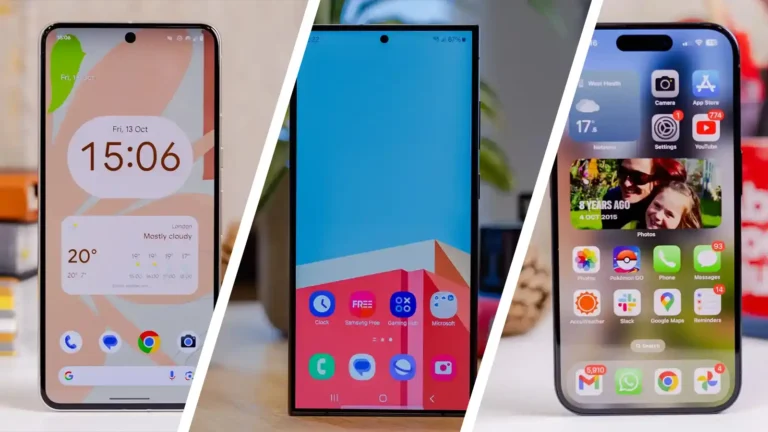Choosing the “best” phone depends on your specific needs and preferences, but here are some of the top smartphones as of 2024:
1. iPhone 15 Pro Max
- Pros: Excellent camera system, powerful A17 Bionic chip, high-quality display, robust ecosystem.
- Cons: Expensive, limited customization.
2. Samsung Galaxy S24 Ultra
- Pros: Outstanding display, versatile camera system, S Pen support, large battery.
- Cons: Expensive, bulky design.
3. Google Pixel 8 Pro
- Pros: Best-in-class camera software, clean Android experience, regular updates, good value.
- Cons: Less powerful hardware compared to other flagships.
4. OnePlus 12
- Pros: Fast performance, good value for money, OxygenOS is close to stock Android.
- Cons: Camera is not as good as competitors, lacks wireless charging.
5. Xiaomi 14 Pro
- Pros: High-end specs, excellent display, good camera, more affordable.
- Cons: MIUI software may not appeal to everyone, limited availability in some regions.
6. Sony Xperia 1 VI
- Pros: 4K OLED display, great for media consumption, pro-level camera features.
- Cons: Expensive, niche appeal.
Factors to Consider:
- Budget: Determine how much you’re willing to spend.
- Camera Quality: Important for photography enthusiasts.
- Performance: Consider the processor, RAM, and storage.
- Battery Life: Essential if you need your phone to last through the day.
- Software: Choose between Android, iOS, or a custom skin.
- Display: Size, resolution, and refresh rate matter if you consume a lot of media.
- Ecosystem: If you have other devices (like tablets, laptops, or smartwatches), consider how well your new phone will integrate.
Depending on what you prioritize, any of these phones could be the best choice for you.
More Considerations When Choosing the Best Phone:
- Design and Build Quality:
- Material: Phones come in various materials like glass, metal, and plastic. Glass backs are premium but can be fragile; metal feels solid but can be slippery; plastic is durable but less luxurious.
- Ergonomics: Consider how the phone feels in your hand. Is it too large or heavy for comfortable use? Does it have sharp edges or a smooth design?
- Operating System and Updates:
- iOS vs. Android: iOS offers a smooth, secure experience with regular updates but limited customization. Android provides more flexibility and customization options but can vary in user experience depending on the manufacturer.
- Update Frequency: iPhones receive updates for several years, making them a good long-term investment. Google’s Pixel phones also receive timely updates. Other Android manufacturers might not be as consistent.
- Camera Features:
- Megapixels: More isn’t always better. Sensor quality and software optimization play significant roles.
- Lenses: Look for phones with multiple lenses (wide, ultra-wide, telephoto) if you want versatility in your photography.
- Software: AI enhancements, night mode, and other software features can significantly improve photo quality.
- Performance:
- Processor: Top-tier processors like Apple’s A-series chips or Qualcomm’s Snapdragon 8 series offer excellent performance for gaming, multitasking, and heavy apps.
- RAM: 8GB is standard for most users, but 12GB or more is ideal for power users who run multiple apps simultaneously.
- Storage: Consider how much storage you need. 128GB is a good starting point, but 256GB or more is better if you store a lot of media.
- Battery and Charging:
- Battery Life: Look for phones with large batteries (4,500mAh or more) if you need all-day battery life.
- Charging Speed: Fast charging (over 30W) can be a game-changer if you’re always on the go. Some phones also support wireless charging, which is convenient but usually slower.
- Display:
- Resolution: Higher resolution (1080p, Quad HD) is great for sharpness, but it can drain the battery faster.
- Refresh Rate: A higher refresh rate (90Hz, 120Hz, or more) makes the screen smoother, especially for gaming and scrolling.
- Type: OLED screens offer better contrast and deeper blacks compared to LCDs.
- 5G Connectivity:
- 5G Support: Most modern phones support 5G, but it’s essential if you live in an area with 5G coverage and want faster internet speeds.
- Dual SIM: Consider if you need dual SIM support, which is helpful for separating work and personal numbers.
- Audio Quality:
- Speakers: Stereo speakers are a plus for media consumption.
- Headphone Jack: If you prefer wired headphones, make sure the phone has a headphone jack, or be prepared to use an adapter.
- Water and Dust Resistance:
- IP Rating: An IP67 or IP68 rating means the phone is water and dust-resistant, which is great for durability.
- Brand Ecosystem and Support:
- Integration: If you’re invested in a particular brand (like Apple, Samsung, or Google), consider how well the phone will integrate with your other devices.
- Customer Support: Some brands offer better customer service, more extended warranties, and more accessible repair options.
Specialized Phones:
- Gaming Phones: If you’re into mobile gaming, consider options like the Asus ROG Phone 7, which offers a high refresh rate, powerful cooling system, and additional gaming accessories.
- Foldable Phones: Samsung’s Galaxy Z Fold 5 and Z Flip 5 are leading in the foldable category, offering innovative designs but at a premium price.
- Budget-Friendly Options: If you’re on a budget, the Google Pixel 7a or Samsung Galaxy A54 offer excellent value with decent performance, cameras, and features.
Final Tips:
- Research and Reviews: Read reviews, watch videos, and try out the phone in-store if possible before making a decision.
- Trade-In and Deals: Many brands and carriers offer trade-in programs or discounts, which can make a flagship phone more affordable.
Ultimately, the best phone is the one that fits your lifestyle, budget, and preferences. Whether you prioritize a top-notch camera, long battery life, or a sleek design, there’s a phone out there that will meet your needs.

